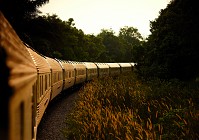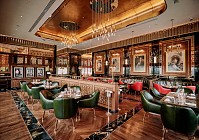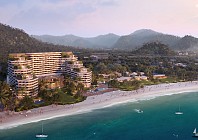THINK of Kuala Lumpur and think of...that’s right, there is nothing to see or do in the capital of the Federation of Malaysia, is there? After looking at a couple of tall buildings, what else is there to do? The truth is that while the tourist masses flock to the beaches in the north to turn pink in the tropical sun, those in the know enjoy the subtle glamour of Kuala Lumpur, one of the world’s most underrated luxury holiday destinations.
Kuala Lumpur doesn’t exactly leap off the page as a primary city-break destination on a par with the likes of Paris, London, or New York, yet it easily satisfies the needs of visitors accustomed to the finer things in life. Thanks to the revenue derived from petroleum and the success of ancillary businesses spawned by that industry, Malaysia has a surprisingly large upper class accustomed to the best that money can buy. Haute couture, fine automobiles, exciting cultural and sporting events – in short, whatever they wish. Overseas tertiary education is de rigueur for well-raised children who return to the country with an enhanced cosmopolitanism already in evidence in this multicultural land, further broadening the worldliness of the Malaysian elite.
We can thank former Prime Minister Tun Dr. Mahathir bin Mohamad for making Malaysia a country with a modern infrastructure, not to mention a world-famous landmark. From the highly polished granite floors of Kuala Lumpur International Airport to the city’s iconic Petronas Towers, Malaysia exhibits a privileged level of economic success in Southeast Asia. A collection of other infrastructure projects around the country were also undertaken to supplement the high-rises in KL’s Golden Triangle, epicentre of the city’s fine restaurants, grand hotels, and deluxe shopping centres.
Those shopping centres are awash in boutiques catering to customers who expect the best. Fashion trends are astutely followed by both men and women, with the offerings of Malaysian designers like Zang Toi and Edmund Ser complementing widely available international brands. Why wear Armani when bespoke clothing can be made to order for a perfect fit? Ladies with an interest in shoes may be surprised to know that famed shoe designer Jimmy Choo is from Malaysia, though these days he leaves footprints across the globe as an official tourism ambassador for his country, working towards increasing awareness of Malaysia’s growing list of attractions.
Some people already know Malaysia is one of the few Asian countries to manufacture its own brand of cars; Malaysian Protons are churned out in the thousands and exported worldwide. Few people, however, know that there is a much more exclusive car made in Malaysia. Literally made-to-measure, the cars of Bufori are produced one by one, entirely by hand, by a team of dedicated artisans with a passion for automobiles. No other car in the world is created with so much attention to detail, with such meticulous skill.
Bufori began as a project of Australian Gerry Khouri, who built a car for himself from the ground up as a challenge to create the exact vehicle he wanted. The finished product was so impressive that brothers and friends requested their own, and soon Gerry found himself building cars one after the other. During an auto exhibition on the idyllic Malaysian island of Langkawi, no less then Dr. Mahathir himself was so impressed with the Bufori on display that he encouraged Khouri to relocate to Malaysia and open a workshop for his cars. He did exactly that in 1990, and ever since has been making custom-made cars for those who can afford the US $130,000-$200,000 price tag, which can go much higher depending on the finishings desired by the buyer.
Even those who don’t consider themselves car enthusiasts would be impressed by Bufori. In the first step after initial consultations, the new owner is measured as if for a new suit. Every car is built to the individual measurements of the owner; the steering wheel, seat distance to pedals, even the wheelbase itself are all adjusted accordingly. The owner decides every detail, from the exterior colour(s) to the degree of softness for the armrests. The result, every time, is a beautiful machine exuding luxury that turns heads absolutely everywhere.
A spin around town will reveal the real truth about Kuala Lumpur. Yes, in fact, there are sights to be seen and scenes to be sighted, not to mention excellent restaurants where the best of Southeast Asian cuisines are brought together in exquisitely prepared dishes reflecting Malaysia’s multicultural society. One of the best sights in the city is barely known to the locals.
The fine gallery of contemporary Malaysian art, owned by the Central Bank Of Malaysia (Bank Negara) is located inside the Central Bank tucked up on a hill just north of the city centre. The collection is on display at the Bank’s Muzium dan Galeri Seni in Sasana Kijang, a landmark building that is itself a work of art. This being the Central Bank, downstairs from the art museum is a museum of money, with the history of coins and currency in Malaysia presented in engaging, high-tech displays.
More public art forum than gallery, the Galeri Petronas inside the KLCC shopping centre is attached to the city’s famous towers. Around Galeri Petronas are several art and antiques shops as well as high-fashion boutiques for both men and women.
Also not to be missed is the Museum of Islamic Arts Malaysia, an outstanding collection of art and artefacts displayed in a beautiful building located adjacent to Kuala Lumpur’s expansive Lake Gardens. Most notable among the collections are the scale models of the world’s most beautiful mosques. The Museum’s gift shop, no ordinary boutique, is worth a look as much as the exhibits are; the shop sells authentic works of art, not just replicas of items on display.
In the general vicinity of the Museum of Islamic Arts is the architectural marvel of the old Kuala Lumpur train station, used today by Orient-Express’ superb Eastern & Oriental Express train, linking the city with Singapore to the south and Bangkok to the north.
Kuala Lumpur’s most impressive spectacle of all, the entrancing Thaipusam Festival, usually takes place every year in February and attracts huge crowds of participants and spectators. Entrancing it certainly is – devotees to the deity Thai who fall into a trance are pierced with a variety of sharp objects ranging from simple safety pins to rather intimidating spikes and arrows.
From thin hooks are dangled miniature jugs of milk as token offerings to the deity. The spectacle begins well before dawn and lasts throughout the day as the pilgrims head out from Kuala Lumpur to Batu Caves outside the city, where they ascend steep staircases to reach the temple of devotion. While Thaipusam is not for the fainthearted, it is undoubtedly one of the most unusual events on the world cultural calendar.
To see KL’s most impressive permanent sight, head to Traders Hotel, located at Kuala Lumpur City Centre, a massive shopping and office complex that incorporates the famous Petronas Towers and is universally known as KLCC. At Traders, the best views of this modern marvel of engineering are seen from the large corner rooms ending in ‘23’ (‘the 23 series’) situated at the end of the corridor on each floor, as well as the hotel’s stunning rooftop Skybar, one of the city’s trendiest watering holes. The traditional Malaysian nasi lemak rice dish is at its best here in Traders’ Godo restaurant, while Godo Upstairs serves the best cuts of Australian beef grilled to perfection. Traders is connected via an air-conditioned, elevated walkway to the fashionable Bukit Bintang shopping/restaurant/bar district that includes Pavilion and Starhill Gallery, two of KL’s most exclusive shopping centres.
Traders’ big sister, Shangri-La Hotel Kuala Lumpur, is even more alluring. Shangri-La hotels are famous for their level of luxury and attentive service, but the company’s Kuala Lumpur property shines bright as one of the most impressive in the group’s portfolio. With Malaysian billionaire Tan Sri Robert Kuok as the hotel group’s owner, it is no surprise that Shangri-La Kuala Lumpur is considered to be something of a showpiece for the company. Rooms and suites at Shangri-La are spacious and luxurious, and the hotel’s lobby serves as Kuala Lumpur’s grand salon, where power-brokers, socialites, and the occasional mere mortal enjoy the fine service and dense jungle vegetation on the other side of an enormous glass wall.
Malaysians love good food and the Shangri-La is no place to skip meals, with two of KL’s best restaurants right in the building. Zipangu, the city’s leading Japanese restaurant, reminds customers of the depth of refinement in Japanese cuisine, while Lafite, the French restaurant now under the meticulous supervision of executive chef John Nash, exudes a sublime air of elegance and privacy, making it a perfect microcosm of Kuala Lumpur itself.
THE GOLDEN BOOK
Shangri-La Kuala Lumpur
Tel: +60 3 2074 3901
www.shangri-la.com
Traders Hotel Kuala Lumpur
Tel: +60 3 2332 9888
www.shangri-la.com















